An Analysis of Leadership, Change Management, and Strategy at Samsung
VerifiedAdded on 2022/12/29
|11
|3058
|30
Report
AI Summary
This report provides a comprehensive analysis of leadership, change management, and strategic planning, using the Samsung case study as a central example. The report begins by defining inclusive leadership, contrasting it with transformational leadership, and outlining the benefits of an inclusive organizational culture. It then examines the concept of resistance to change, exploring whether Samsung's failure can be attributed to it and suggesting preventative measures. The report contrasts planned and unplanned change management processes, identifying key theories and their advantages and limitations. Finally, the report defines strategy, analyzes Samsung's strategic positioning, and applies the Whittington model, while also discussing the limitations of a prescriptive approach. The analysis covers various aspects of leadership, change management, and strategic planning, offering insights into organizational success and failure.
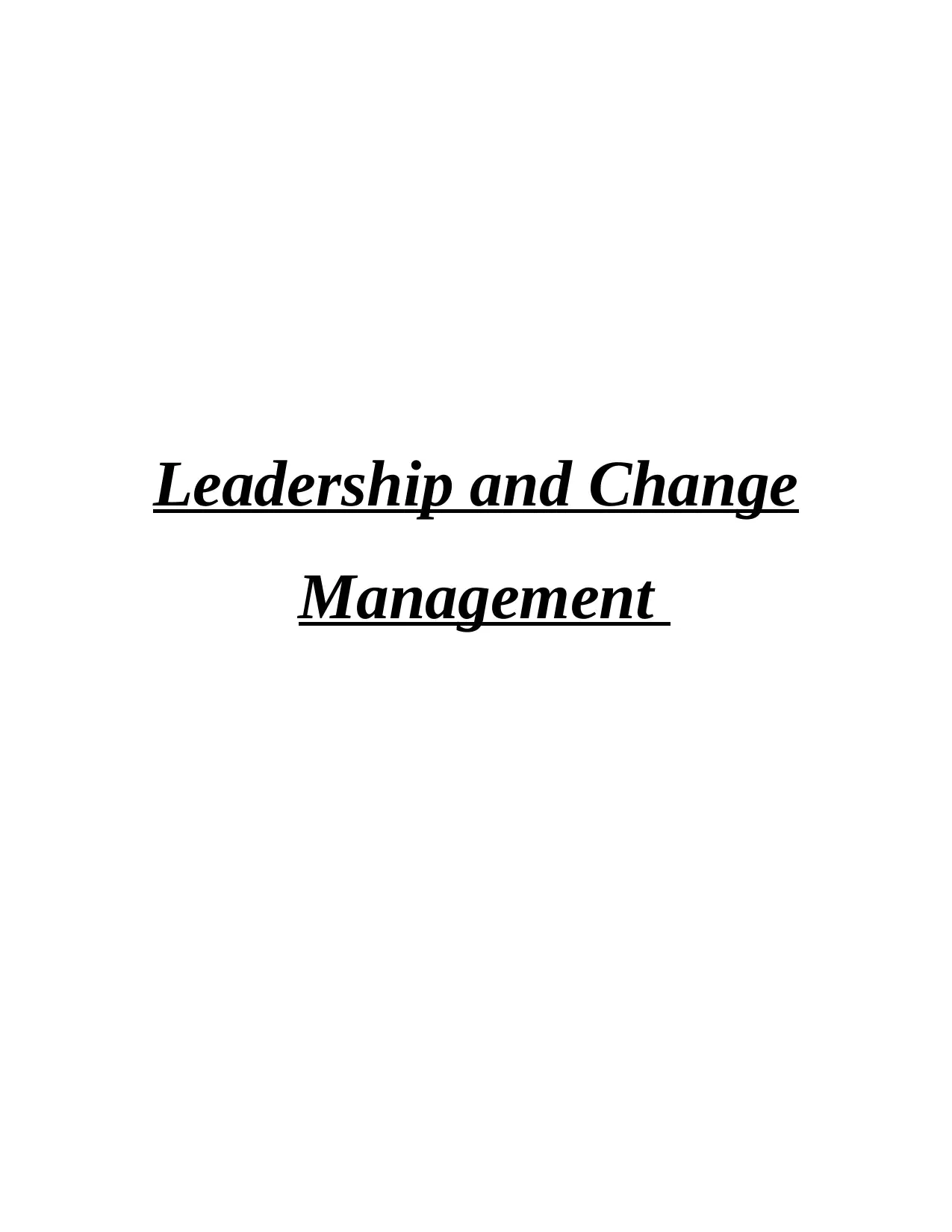
Leadership and Change
Management
Management
Paraphrase This Document
Need a fresh take? Get an instant paraphrase of this document with our AI Paraphraser
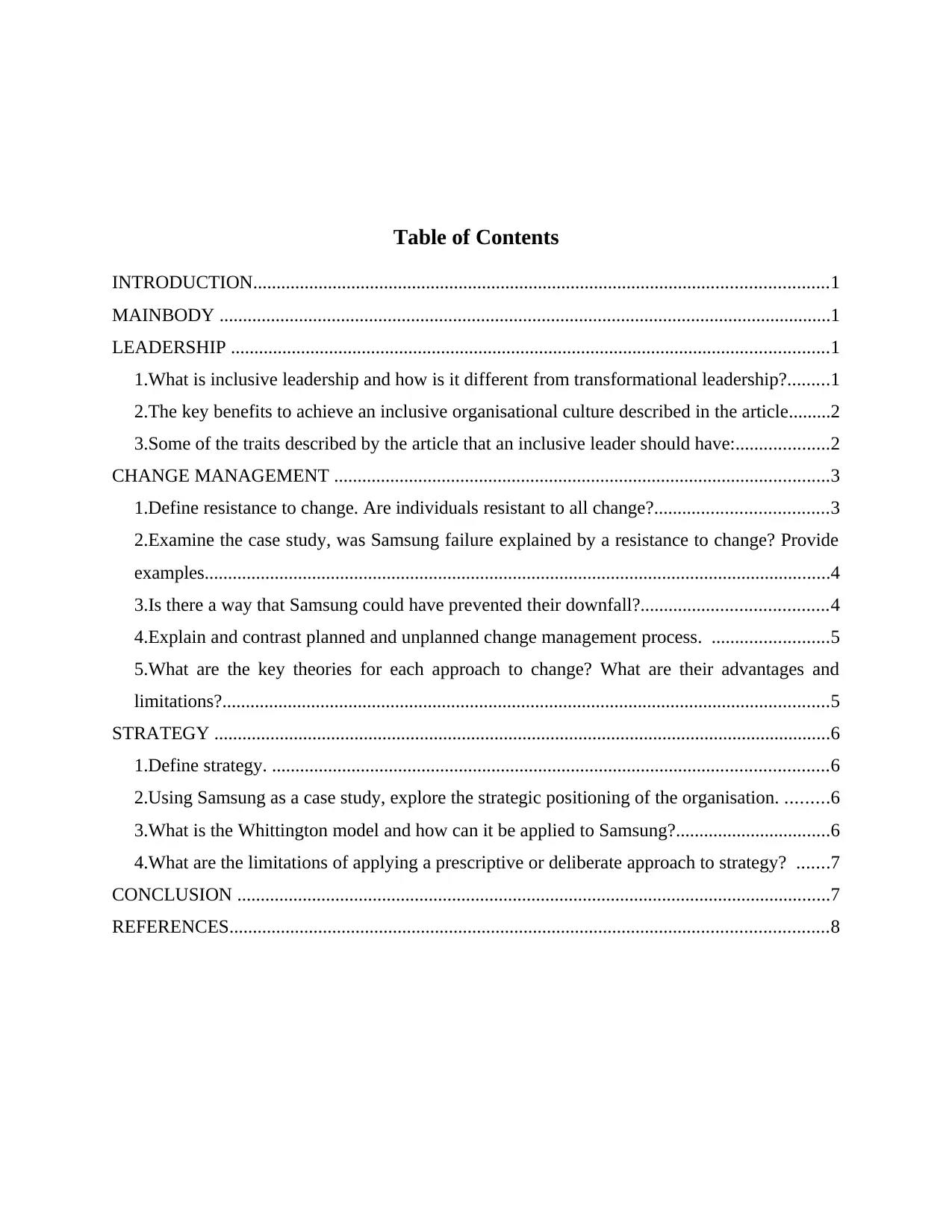
Table of Contents
INTRODUCTION...........................................................................................................................1
MAINBODY ...................................................................................................................................1
LEADERSHIP ................................................................................................................................1
1.What is inclusive leadership and how is it different from transformational leadership?.........1
2.The key benefits to achieve an inclusive organisational culture described in the article.........2
3.Some of the traits described by the article that an inclusive leader should have:....................2
CHANGE MANAGEMENT ..........................................................................................................3
1.Define resistance to change. Are individuals resistant to all change?.....................................3
2.Examine the case study, was Samsung failure explained by a resistance to change? Provide
examples......................................................................................................................................4
3.Is there a way that Samsung could have prevented their downfall?........................................4
4.Explain and contrast planned and unplanned change management process. .........................5
5.What are the key theories for each approach to change? What are their advantages and
limitations?..................................................................................................................................5
STRATEGY ....................................................................................................................................6
1.Define strategy. .......................................................................................................................6
2.Using Samsung as a case study, explore the strategic positioning of the organisation. .........6
3.What is the Whittington model and how can it be applied to Samsung?.................................6
4.What are the limitations of applying a prescriptive or deliberate approach to strategy? .......7
CONCLUSION ...............................................................................................................................7
REFERENCES................................................................................................................................8
INTRODUCTION...........................................................................................................................1
MAINBODY ...................................................................................................................................1
LEADERSHIP ................................................................................................................................1
1.What is inclusive leadership and how is it different from transformational leadership?.........1
2.The key benefits to achieve an inclusive organisational culture described in the article.........2
3.Some of the traits described by the article that an inclusive leader should have:....................2
CHANGE MANAGEMENT ..........................................................................................................3
1.Define resistance to change. Are individuals resistant to all change?.....................................3
2.Examine the case study, was Samsung failure explained by a resistance to change? Provide
examples......................................................................................................................................4
3.Is there a way that Samsung could have prevented their downfall?........................................4
4.Explain and contrast planned and unplanned change management process. .........................5
5.What are the key theories for each approach to change? What are their advantages and
limitations?..................................................................................................................................5
STRATEGY ....................................................................................................................................6
1.Define strategy. .......................................................................................................................6
2.Using Samsung as a case study, explore the strategic positioning of the organisation. .........6
3.What is the Whittington model and how can it be applied to Samsung?.................................6
4.What are the limitations of applying a prescriptive or deliberate approach to strategy? .......7
CONCLUSION ...............................................................................................................................7
REFERENCES................................................................................................................................8
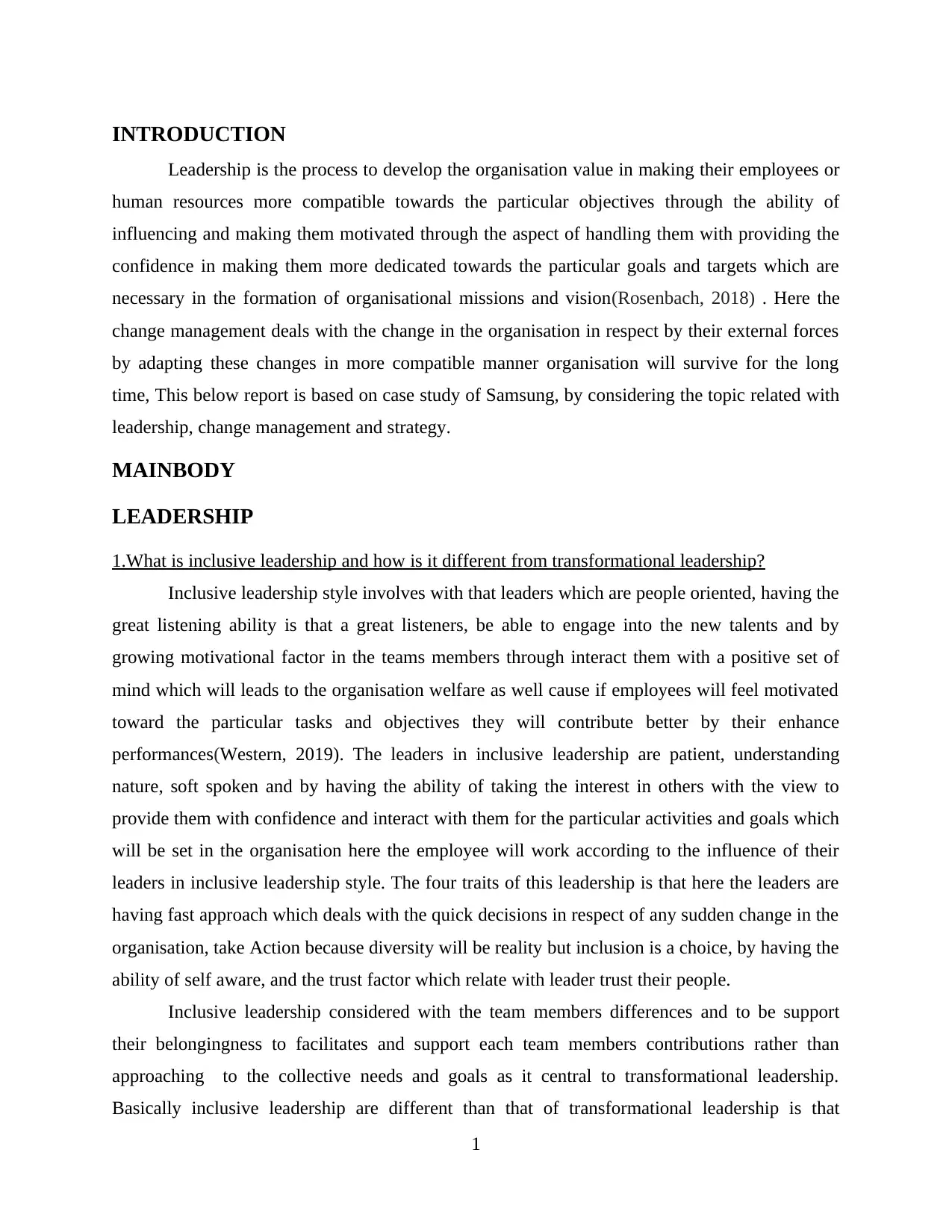
INTRODUCTION
Leadership is the process to develop the organisation value in making their employees or
human resources more compatible towards the particular objectives through the ability of
influencing and making them motivated through the aspect of handling them with providing the
confidence in making them more dedicated towards the particular goals and targets which are
necessary in the formation of organisational missions and vision(Rosenbach, 2018) . Here the
change management deals with the change in the organisation in respect by their external forces
by adapting these changes in more compatible manner organisation will survive for the long
time, This below report is based on case study of Samsung, by considering the topic related with
leadership, change management and strategy.
MAINBODY
LEADERSHIP
1.What is inclusive leadership and how is it different from transformational leadership?
Inclusive leadership style involves with that leaders which are people oriented, having the
great listening ability is that a great listeners, be able to engage into the new talents and by
growing motivational factor in the teams members through interact them with a positive set of
mind which will leads to the organisation welfare as well cause if employees will feel motivated
toward the particular tasks and objectives they will contribute better by their enhance
performances(Western, 2019). The leaders in inclusive leadership are patient, understanding
nature, soft spoken and by having the ability of taking the interest in others with the view to
provide them with confidence and interact with them for the particular activities and goals which
will be set in the organisation here the employee will work according to the influence of their
leaders in inclusive leadership style. The four traits of this leadership is that here the leaders are
having fast approach which deals with the quick decisions in respect of any sudden change in the
organisation, take Action because diversity will be reality but inclusion is a choice, by having the
ability of self aware, and the trust factor which relate with leader trust their people.
Inclusive leadership considered with the team members differences and to be support
their belongingness to facilitates and support each team members contributions rather than
approaching to the collective needs and goals as it central to transformational leadership.
Basically inclusive leadership are different than that of transformational leadership is that
1
Leadership is the process to develop the organisation value in making their employees or
human resources more compatible towards the particular objectives through the ability of
influencing and making them motivated through the aspect of handling them with providing the
confidence in making them more dedicated towards the particular goals and targets which are
necessary in the formation of organisational missions and vision(Rosenbach, 2018) . Here the
change management deals with the change in the organisation in respect by their external forces
by adapting these changes in more compatible manner organisation will survive for the long
time, This below report is based on case study of Samsung, by considering the topic related with
leadership, change management and strategy.
MAINBODY
LEADERSHIP
1.What is inclusive leadership and how is it different from transformational leadership?
Inclusive leadership style involves with that leaders which are people oriented, having the
great listening ability is that a great listeners, be able to engage into the new talents and by
growing motivational factor in the teams members through interact them with a positive set of
mind which will leads to the organisation welfare as well cause if employees will feel motivated
toward the particular tasks and objectives they will contribute better by their enhance
performances(Western, 2019). The leaders in inclusive leadership are patient, understanding
nature, soft spoken and by having the ability of taking the interest in others with the view to
provide them with confidence and interact with them for the particular activities and goals which
will be set in the organisation here the employee will work according to the influence of their
leaders in inclusive leadership style. The four traits of this leadership is that here the leaders are
having fast approach which deals with the quick decisions in respect of any sudden change in the
organisation, take Action because diversity will be reality but inclusion is a choice, by having the
ability of self aware, and the trust factor which relate with leader trust their people.
Inclusive leadership considered with the team members differences and to be support
their belongingness to facilitates and support each team members contributions rather than
approaching to the collective needs and goals as it central to transformational leadership.
Basically inclusive leadership are different than that of transformational leadership is that
1
⊘ This is a preview!⊘
Do you want full access?
Subscribe today to unlock all pages.

Trusted by 1+ million students worldwide
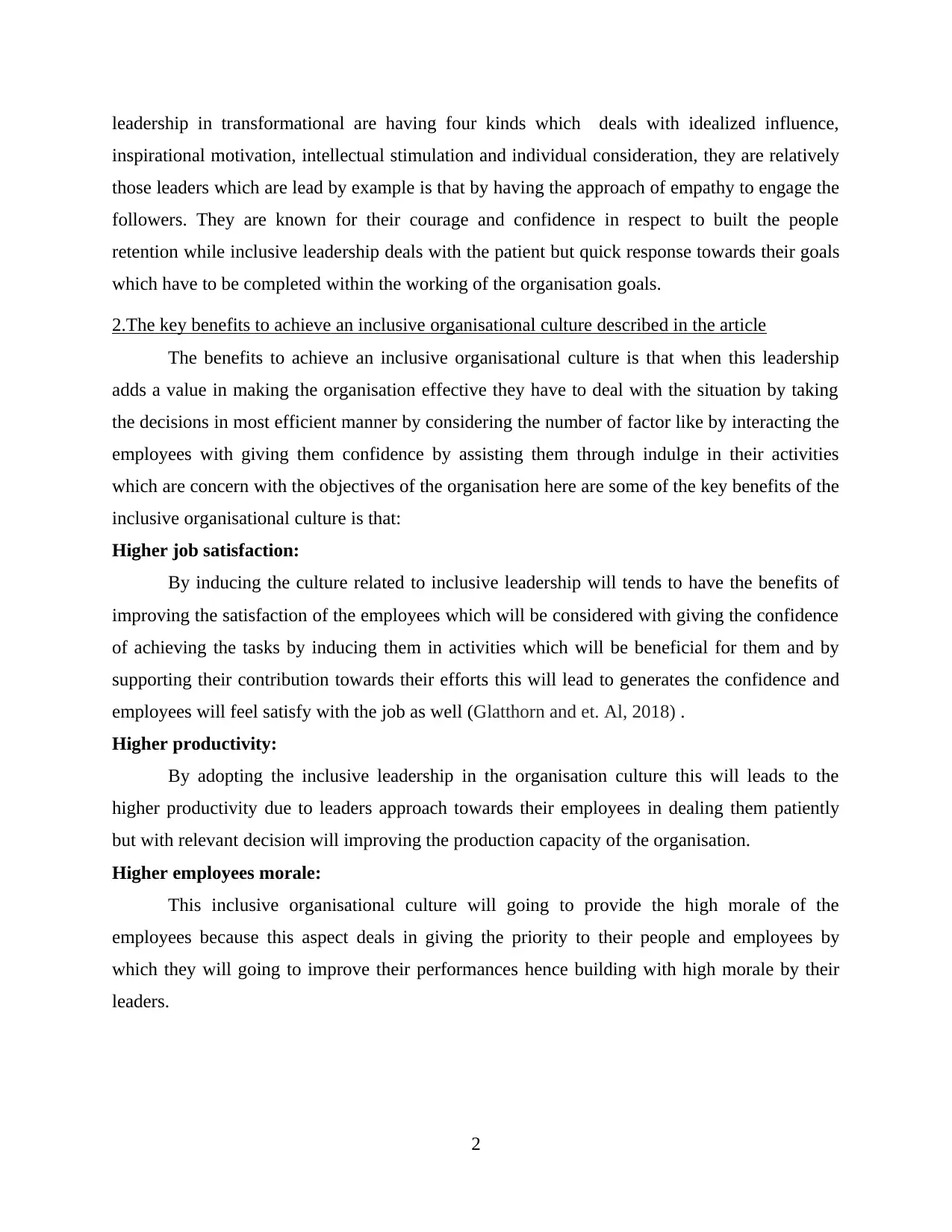
leadership in transformational are having four kinds which deals with idealized influence,
inspirational motivation, intellectual stimulation and individual consideration, they are relatively
those leaders which are lead by example is that by having the approach of empathy to engage the
followers. They are known for their courage and confidence in respect to built the people
retention while inclusive leadership deals with the patient but quick response towards their goals
which have to be completed within the working of the organisation goals.
2.The key benefits to achieve an inclusive organisational culture described in the article
The benefits to achieve an inclusive organisational culture is that when this leadership
adds a value in making the organisation effective they have to deal with the situation by taking
the decisions in most efficient manner by considering the number of factor like by interacting the
employees with giving them confidence by assisting them through indulge in their activities
which are concern with the objectives of the organisation here are some of the key benefits of the
inclusive organisational culture is that:
Higher job satisfaction:
By inducing the culture related to inclusive leadership will tends to have the benefits of
improving the satisfaction of the employees which will be considered with giving the confidence
of achieving the tasks by inducing them in activities which will be beneficial for them and by
supporting their contribution towards their efforts this will lead to generates the confidence and
employees will feel satisfy with the job as well (Glatthorn and et. Al, 2018) .
Higher productivity:
By adopting the inclusive leadership in the organisation culture this will leads to the
higher productivity due to leaders approach towards their employees in dealing them patiently
but with relevant decision will improving the production capacity of the organisation.
Higher employees morale:
This inclusive organisational culture will going to provide the high morale of the
employees because this aspect deals in giving the priority to their people and employees by
which they will going to improve their performances hence building with high morale by their
leaders.
2
inspirational motivation, intellectual stimulation and individual consideration, they are relatively
those leaders which are lead by example is that by having the approach of empathy to engage the
followers. They are known for their courage and confidence in respect to built the people
retention while inclusive leadership deals with the patient but quick response towards their goals
which have to be completed within the working of the organisation goals.
2.The key benefits to achieve an inclusive organisational culture described in the article
The benefits to achieve an inclusive organisational culture is that when this leadership
adds a value in making the organisation effective they have to deal with the situation by taking
the decisions in most efficient manner by considering the number of factor like by interacting the
employees with giving them confidence by assisting them through indulge in their activities
which are concern with the objectives of the organisation here are some of the key benefits of the
inclusive organisational culture is that:
Higher job satisfaction:
By inducing the culture related to inclusive leadership will tends to have the benefits of
improving the satisfaction of the employees which will be considered with giving the confidence
of achieving the tasks by inducing them in activities which will be beneficial for them and by
supporting their contribution towards their efforts this will lead to generates the confidence and
employees will feel satisfy with the job as well (Glatthorn and et. Al, 2018) .
Higher productivity:
By adopting the inclusive leadership in the organisation culture this will leads to the
higher productivity due to leaders approach towards their employees in dealing them patiently
but with relevant decision will improving the production capacity of the organisation.
Higher employees morale:
This inclusive organisational culture will going to provide the high morale of the
employees because this aspect deals in giving the priority to their people and employees by
which they will going to improve their performances hence building with high morale by their
leaders.
2
Paraphrase This Document
Need a fresh take? Get an instant paraphrase of this document with our AI Paraphraser
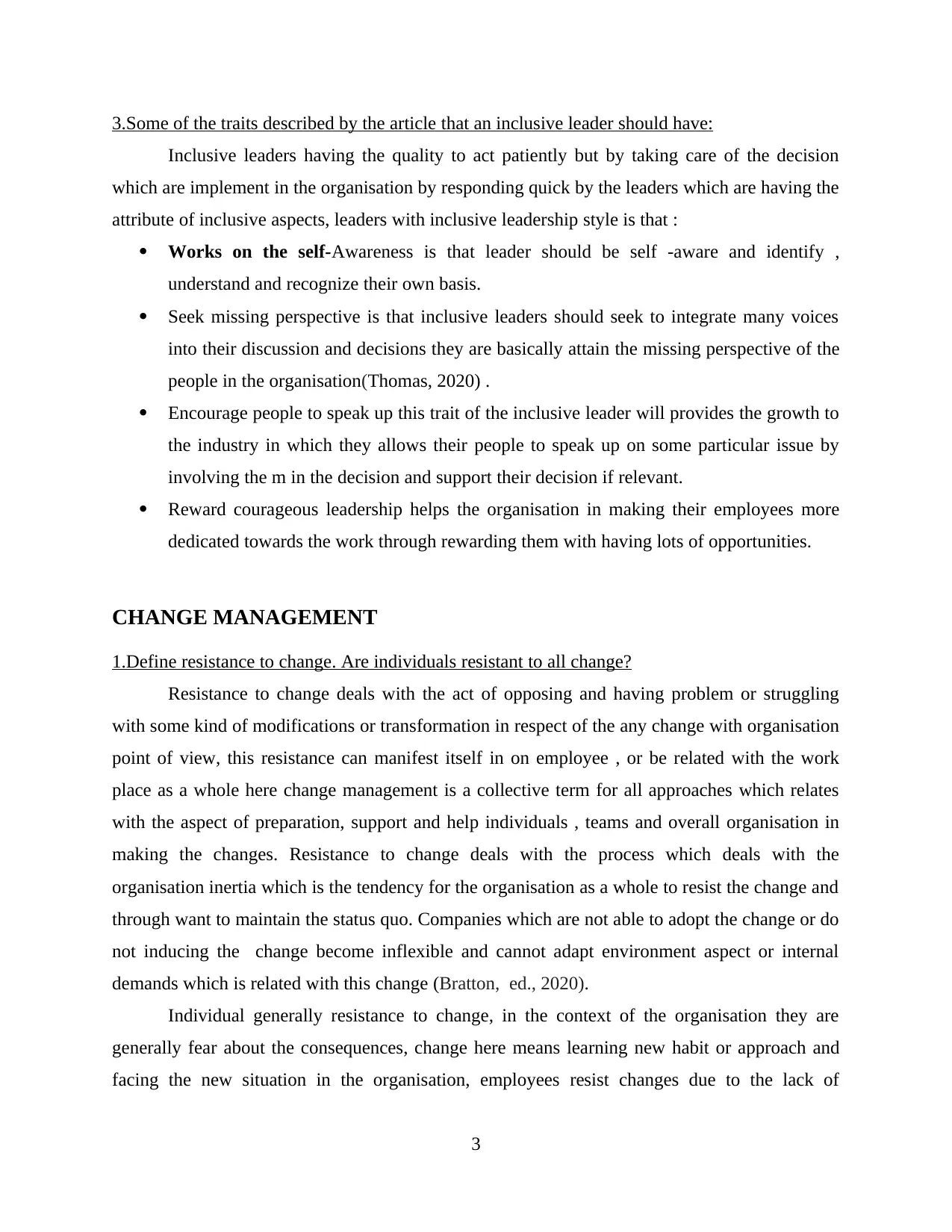
3.Some of the traits described by the article that an inclusive leader should have:
Inclusive leaders having the quality to act patiently but by taking care of the decision
which are implement in the organisation by responding quick by the leaders which are having the
attribute of inclusive aspects, leaders with inclusive leadership style is that :
Works on the self-Awareness is that leader should be self -aware and identify ,
understand and recognize their own basis.
Seek missing perspective is that inclusive leaders should seek to integrate many voices
into their discussion and decisions they are basically attain the missing perspective of the
people in the organisation(Thomas, 2020) .
Encourage people to speak up this trait of the inclusive leader will provides the growth to
the industry in which they allows their people to speak up on some particular issue by
involving the m in the decision and support their decision if relevant.
Reward courageous leadership helps the organisation in making their employees more
dedicated towards the work through rewarding them with having lots of opportunities.
CHANGE MANAGEMENT
1.Define resistance to change. Are individuals resistant to all change?
Resistance to change deals with the act of opposing and having problem or struggling
with some kind of modifications or transformation in respect of the any change with organisation
point of view, this resistance can manifest itself in on employee , or be related with the work
place as a whole here change management is a collective term for all approaches which relates
with the aspect of preparation, support and help individuals , teams and overall organisation in
making the changes. Resistance to change deals with the process which deals with the
organisation inertia which is the tendency for the organisation as a whole to resist the change and
through want to maintain the status quo. Companies which are not able to adopt the change or do
not inducing the change become inflexible and cannot adapt environment aspect or internal
demands which is related with this change (Bratton, ed., 2020).
Individual generally resistance to change, in the context of the organisation they are
generally fear about the consequences, change here means learning new habit or approach and
facing the new situation in the organisation, employees resist changes due to the lack of
3
Inclusive leaders having the quality to act patiently but by taking care of the decision
which are implement in the organisation by responding quick by the leaders which are having the
attribute of inclusive aspects, leaders with inclusive leadership style is that :
Works on the self-Awareness is that leader should be self -aware and identify ,
understand and recognize their own basis.
Seek missing perspective is that inclusive leaders should seek to integrate many voices
into their discussion and decisions they are basically attain the missing perspective of the
people in the organisation(Thomas, 2020) .
Encourage people to speak up this trait of the inclusive leader will provides the growth to
the industry in which they allows their people to speak up on some particular issue by
involving the m in the decision and support their decision if relevant.
Reward courageous leadership helps the organisation in making their employees more
dedicated towards the work through rewarding them with having lots of opportunities.
CHANGE MANAGEMENT
1.Define resistance to change. Are individuals resistant to all change?
Resistance to change deals with the act of opposing and having problem or struggling
with some kind of modifications or transformation in respect of the any change with organisation
point of view, this resistance can manifest itself in on employee , or be related with the work
place as a whole here change management is a collective term for all approaches which relates
with the aspect of preparation, support and help individuals , teams and overall organisation in
making the changes. Resistance to change deals with the process which deals with the
organisation inertia which is the tendency for the organisation as a whole to resist the change and
through want to maintain the status quo. Companies which are not able to adopt the change or do
not inducing the change become inflexible and cannot adapt environment aspect or internal
demands which is related with this change (Bratton, ed., 2020).
Individual generally resistance to change, in the context of the organisation they are
generally fear about the consequences, change here means learning new habit or approach and
facing the new situation in the organisation, employees resist changes due to the lack of
3
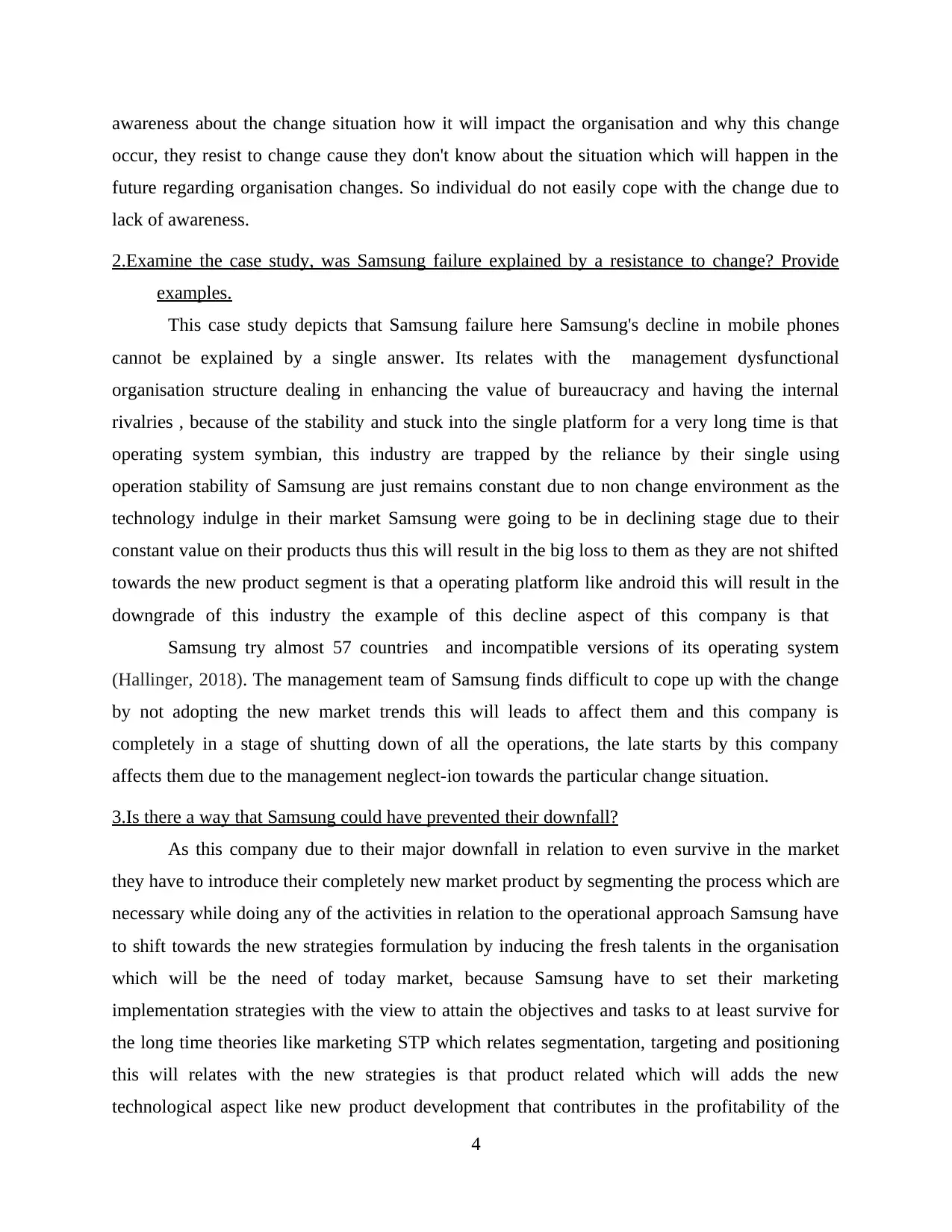
awareness about the change situation how it will impact the organisation and why this change
occur, they resist to change cause they don't know about the situation which will happen in the
future regarding organisation changes. So individual do not easily cope with the change due to
lack of awareness.
2.Examine the case study, was Samsung failure explained by a resistance to change? Provide
examples.
This case study depicts that Samsung failure here Samsung's decline in mobile phones
cannot be explained by a single answer. Its relates with the management dysfunctional
organisation structure dealing in enhancing the value of bureaucracy and having the internal
rivalries , because of the stability and stuck into the single platform for a very long time is that
operating system symbian, this industry are trapped by the reliance by their single using
operation stability of Samsung are just remains constant due to non change environment as the
technology indulge in their market Samsung were going to be in declining stage due to their
constant value on their products thus this will result in the big loss to them as they are not shifted
towards the new product segment is that a operating platform like android this will result in the
downgrade of this industry the example of this decline aspect of this company is that
Samsung try almost 57 countries and incompatible versions of its operating system
(Hallinger, 2018). The management team of Samsung finds difficult to cope up with the change
by not adopting the new market trends this will leads to affect them and this company is
completely in a stage of shutting down of all the operations, the late starts by this company
affects them due to the management neglect-ion towards the particular change situation.
3.Is there a way that Samsung could have prevented their downfall?
As this company due to their major downfall in relation to even survive in the market
they have to introduce their completely new market product by segmenting the process which are
necessary while doing any of the activities in relation to the operational approach Samsung have
to shift towards the new strategies formulation by inducing the fresh talents in the organisation
which will be the need of today market, because Samsung have to set their marketing
implementation strategies with the view to attain the objectives and tasks to at least survive for
the long time theories like marketing STP which relates segmentation, targeting and positioning
this will relates with the new strategies is that product related which will adds the new
technological aspect like new product development that contributes in the profitability of the
4
occur, they resist to change cause they don't know about the situation which will happen in the
future regarding organisation changes. So individual do not easily cope with the change due to
lack of awareness.
2.Examine the case study, was Samsung failure explained by a resistance to change? Provide
examples.
This case study depicts that Samsung failure here Samsung's decline in mobile phones
cannot be explained by a single answer. Its relates with the management dysfunctional
organisation structure dealing in enhancing the value of bureaucracy and having the internal
rivalries , because of the stability and stuck into the single platform for a very long time is that
operating system symbian, this industry are trapped by the reliance by their single using
operation stability of Samsung are just remains constant due to non change environment as the
technology indulge in their market Samsung were going to be in declining stage due to their
constant value on their products thus this will result in the big loss to them as they are not shifted
towards the new product segment is that a operating platform like android this will result in the
downgrade of this industry the example of this decline aspect of this company is that
Samsung try almost 57 countries and incompatible versions of its operating system
(Hallinger, 2018). The management team of Samsung finds difficult to cope up with the change
by not adopting the new market trends this will leads to affect them and this company is
completely in a stage of shutting down of all the operations, the late starts by this company
affects them due to the management neglect-ion towards the particular change situation.
3.Is there a way that Samsung could have prevented their downfall?
As this company due to their major downfall in relation to even survive in the market
they have to introduce their completely new market product by segmenting the process which are
necessary while doing any of the activities in relation to the operational approach Samsung have
to shift towards the new strategies formulation by inducing the fresh talents in the organisation
which will be the need of today market, because Samsung have to set their marketing
implementation strategies with the view to attain the objectives and tasks to at least survive for
the long time theories like marketing STP which relates segmentation, targeting and positioning
this will relates with the new strategies is that product related which will adds the new
technological aspect like new product development that contributes in the profitability of the
4
⊘ This is a preview!⊘
Do you want full access?
Subscribe today to unlock all pages.

Trusted by 1+ million students worldwide
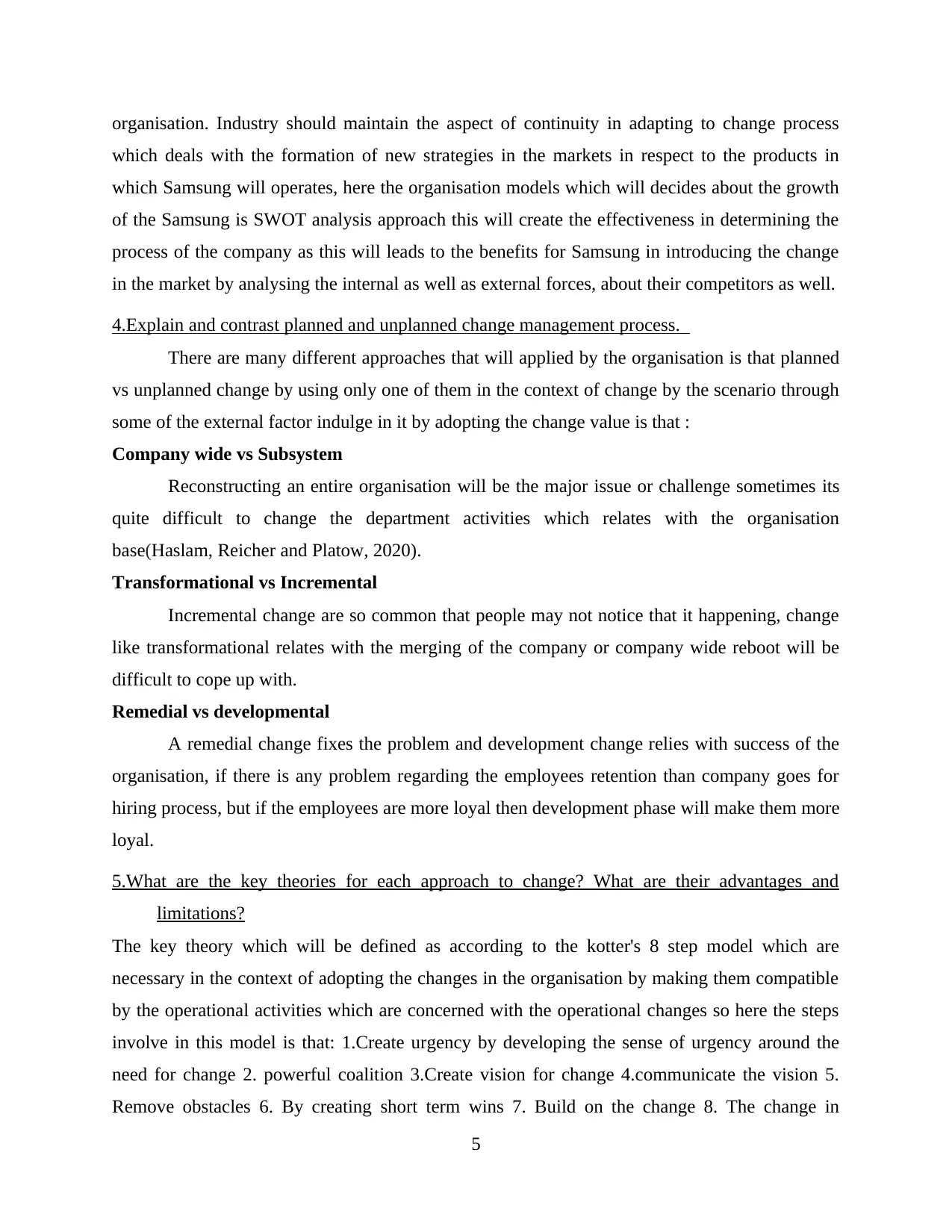
organisation. Industry should maintain the aspect of continuity in adapting to change process
which deals with the formation of new strategies in the markets in respect to the products in
which Samsung will operates, here the organisation models which will decides about the growth
of the Samsung is SWOT analysis approach this will create the effectiveness in determining the
process of the company as this will leads to the benefits for Samsung in introducing the change
in the market by analysing the internal as well as external forces, about their competitors as well.
4.Explain and contrast planned and unplanned change management process.
There are many different approaches that will applied by the organisation is that planned
vs unplanned change by using only one of them in the context of change by the scenario through
some of the external factor indulge in it by adopting the change value is that :
Company wide vs Subsystem
Reconstructing an entire organisation will be the major issue or challenge sometimes its
quite difficult to change the department activities which relates with the organisation
base(Haslam, Reicher and Platow, 2020).
Transformational vs Incremental
Incremental change are so common that people may not notice that it happening, change
like transformational relates with the merging of the company or company wide reboot will be
difficult to cope up with.
Remedial vs developmental
A remedial change fixes the problem and development change relies with success of the
organisation, if there is any problem regarding the employees retention than company goes for
hiring process, but if the employees are more loyal then development phase will make them more
loyal.
5.What are the key theories for each approach to change? What are their advantages and
limitations?
The key theory which will be defined as according to the kotter's 8 step model which are
necessary in the context of adopting the changes in the organisation by making them compatible
by the operational activities which are concerned with the operational changes so here the steps
involve in this model is that: 1.Create urgency by developing the sense of urgency around the
need for change 2. powerful coalition 3.Create vision for change 4.communicate the vision 5.
Remove obstacles 6. By creating short term wins 7. Build on the change 8. The change in
5
which deals with the formation of new strategies in the markets in respect to the products in
which Samsung will operates, here the organisation models which will decides about the growth
of the Samsung is SWOT analysis approach this will create the effectiveness in determining the
process of the company as this will leads to the benefits for Samsung in introducing the change
in the market by analysing the internal as well as external forces, about their competitors as well.
4.Explain and contrast planned and unplanned change management process.
There are many different approaches that will applied by the organisation is that planned
vs unplanned change by using only one of them in the context of change by the scenario through
some of the external factor indulge in it by adopting the change value is that :
Company wide vs Subsystem
Reconstructing an entire organisation will be the major issue or challenge sometimes its
quite difficult to change the department activities which relates with the organisation
base(Haslam, Reicher and Platow, 2020).
Transformational vs Incremental
Incremental change are so common that people may not notice that it happening, change
like transformational relates with the merging of the company or company wide reboot will be
difficult to cope up with.
Remedial vs developmental
A remedial change fixes the problem and development change relies with success of the
organisation, if there is any problem regarding the employees retention than company goes for
hiring process, but if the employees are more loyal then development phase will make them more
loyal.
5.What are the key theories for each approach to change? What are their advantages and
limitations?
The key theory which will be defined as according to the kotter's 8 step model which are
necessary in the context of adopting the changes in the organisation by making them compatible
by the operational activities which are concerned with the operational changes so here the steps
involve in this model is that: 1.Create urgency by developing the sense of urgency around the
need for change 2. powerful coalition 3.Create vision for change 4.communicate the vision 5.
Remove obstacles 6. By creating short term wins 7. Build on the change 8. The change in
5
Paraphrase This Document
Need a fresh take? Get an instant paraphrase of this document with our AI Paraphraser
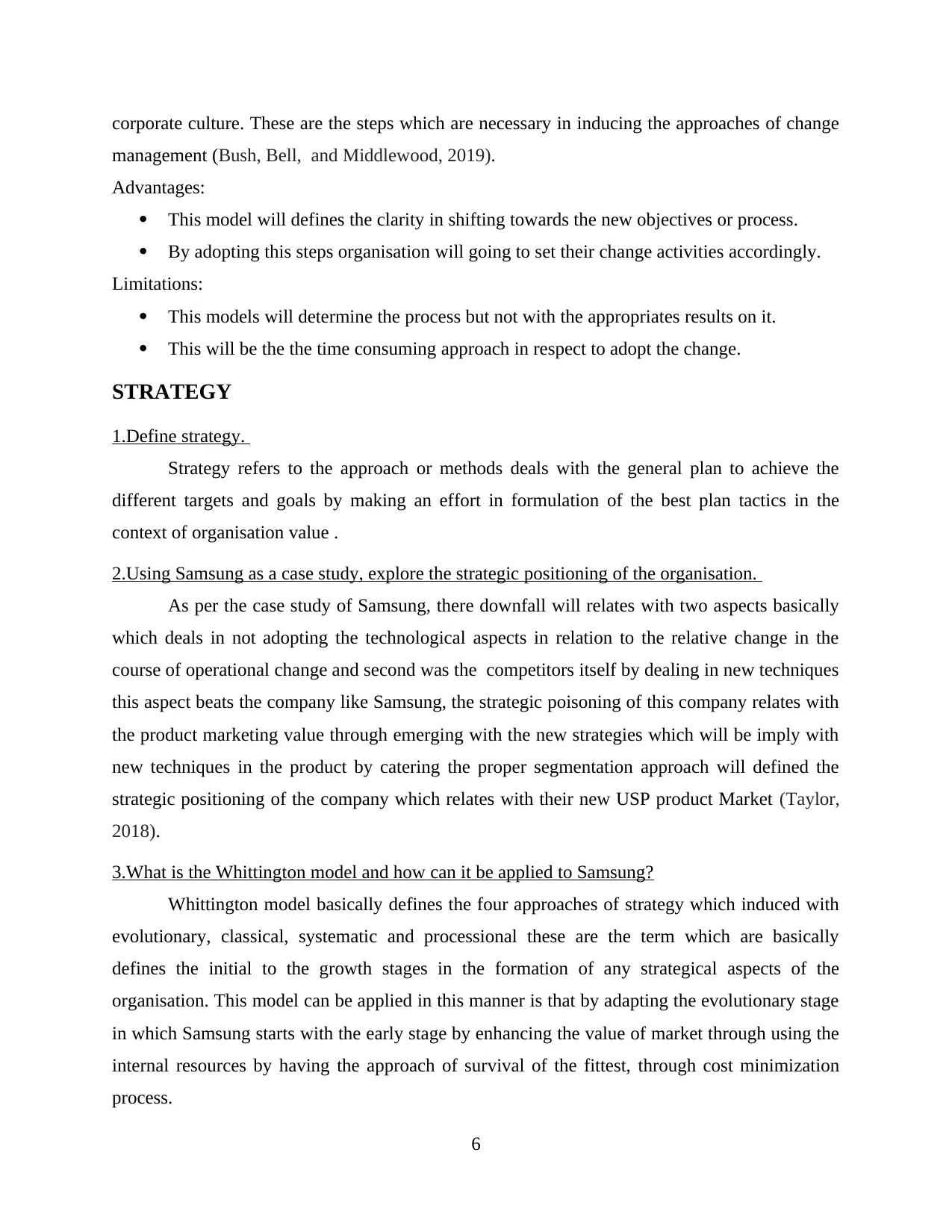
corporate culture. These are the steps which are necessary in inducing the approaches of change
management (Bush, Bell, and Middlewood, 2019).
Advantages:
This model will defines the clarity in shifting towards the new objectives or process.
By adopting this steps organisation will going to set their change activities accordingly.
Limitations:
This models will determine the process but not with the appropriates results on it.
This will be the the time consuming approach in respect to adopt the change.
STRATEGY
1.Define strategy.
Strategy refers to the approach or methods deals with the general plan to achieve the
different targets and goals by making an effort in formulation of the best plan tactics in the
context of organisation value .
2.Using Samsung as a case study, explore the strategic positioning of the organisation.
As per the case study of Samsung, there downfall will relates with two aspects basically
which deals in not adopting the technological aspects in relation to the relative change in the
course of operational change and second was the competitors itself by dealing in new techniques
this aspect beats the company like Samsung, the strategic poisoning of this company relates with
the product marketing value through emerging with the new strategies which will be imply with
new techniques in the product by catering the proper segmentation approach will defined the
strategic positioning of the company which relates with their new USP product Market (Taylor,
2018).
3.What is the Whittington model and how can it be applied to Samsung?
Whittington model basically defines the four approaches of strategy which induced with
evolutionary, classical, systematic and processional these are the term which are basically
defines the initial to the growth stages in the formation of any strategical aspects of the
organisation. This model can be applied in this manner is that by adapting the evolutionary stage
in which Samsung starts with the early stage by enhancing the value of market through using the
internal resources by having the approach of survival of the fittest, through cost minimization
process.
6
management (Bush, Bell, and Middlewood, 2019).
Advantages:
This model will defines the clarity in shifting towards the new objectives or process.
By adopting this steps organisation will going to set their change activities accordingly.
Limitations:
This models will determine the process but not with the appropriates results on it.
This will be the the time consuming approach in respect to adopt the change.
STRATEGY
1.Define strategy.
Strategy refers to the approach or methods deals with the general plan to achieve the
different targets and goals by making an effort in formulation of the best plan tactics in the
context of organisation value .
2.Using Samsung as a case study, explore the strategic positioning of the organisation.
As per the case study of Samsung, there downfall will relates with two aspects basically
which deals in not adopting the technological aspects in relation to the relative change in the
course of operational change and second was the competitors itself by dealing in new techniques
this aspect beats the company like Samsung, the strategic poisoning of this company relates with
the product marketing value through emerging with the new strategies which will be imply with
new techniques in the product by catering the proper segmentation approach will defined the
strategic positioning of the company which relates with their new USP product Market (Taylor,
2018).
3.What is the Whittington model and how can it be applied to Samsung?
Whittington model basically defines the four approaches of strategy which induced with
evolutionary, classical, systematic and processional these are the term which are basically
defines the initial to the growth stages in the formation of any strategical aspects of the
organisation. This model can be applied in this manner is that by adapting the evolutionary stage
in which Samsung starts with the early stage by enhancing the value of market through using the
internal resources by having the approach of survival of the fittest, through cost minimization
process.
6
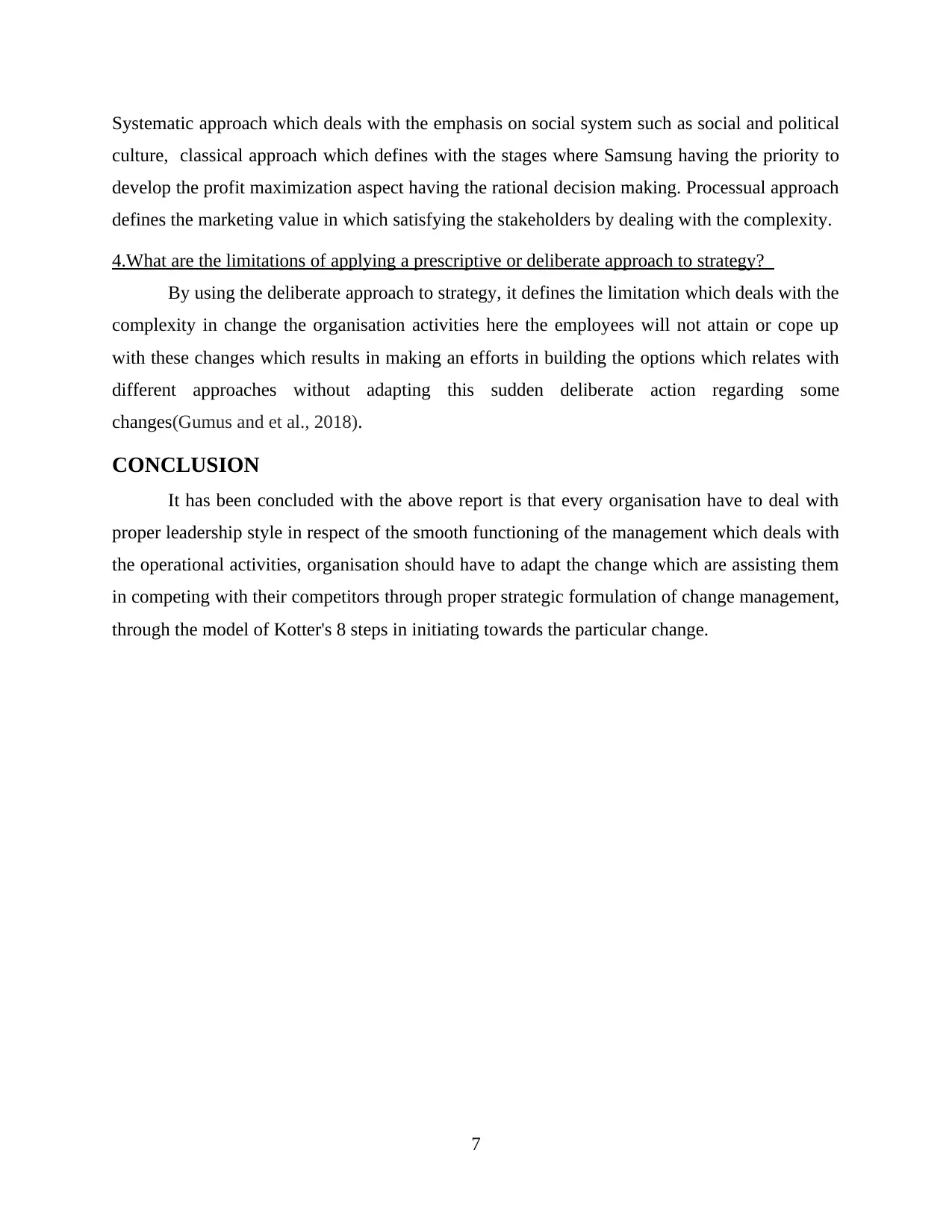
Systematic approach which deals with the emphasis on social system such as social and political
culture, classical approach which defines with the stages where Samsung having the priority to
develop the profit maximization aspect having the rational decision making. Processual approach
defines the marketing value in which satisfying the stakeholders by dealing with the complexity.
4.What are the limitations of applying a prescriptive or deliberate approach to strategy?
By using the deliberate approach to strategy, it defines the limitation which deals with the
complexity in change the organisation activities here the employees will not attain or cope up
with these changes which results in making an efforts in building the options which relates with
different approaches without adapting this sudden deliberate action regarding some
changes(Gumus and et al., 2018).
CONCLUSION
It has been concluded with the above report is that every organisation have to deal with
proper leadership style in respect of the smooth functioning of the management which deals with
the operational activities, organisation should have to adapt the change which are assisting them
in competing with their competitors through proper strategic formulation of change management,
through the model of Kotter's 8 steps in initiating towards the particular change.
7
culture, classical approach which defines with the stages where Samsung having the priority to
develop the profit maximization aspect having the rational decision making. Processual approach
defines the marketing value in which satisfying the stakeholders by dealing with the complexity.
4.What are the limitations of applying a prescriptive or deliberate approach to strategy?
By using the deliberate approach to strategy, it defines the limitation which deals with the
complexity in change the organisation activities here the employees will not attain or cope up
with these changes which results in making an efforts in building the options which relates with
different approaches without adapting this sudden deliberate action regarding some
changes(Gumus and et al., 2018).
CONCLUSION
It has been concluded with the above report is that every organisation have to deal with
proper leadership style in respect of the smooth functioning of the management which deals with
the operational activities, organisation should have to adapt the change which are assisting them
in competing with their competitors through proper strategic formulation of change management,
through the model of Kotter's 8 steps in initiating towards the particular change.
7
⊘ This is a preview!⊘
Do you want full access?
Subscribe today to unlock all pages.

Trusted by 1+ million students worldwide

8
Paraphrase This Document
Need a fresh take? Get an instant paraphrase of this document with our AI Paraphraser
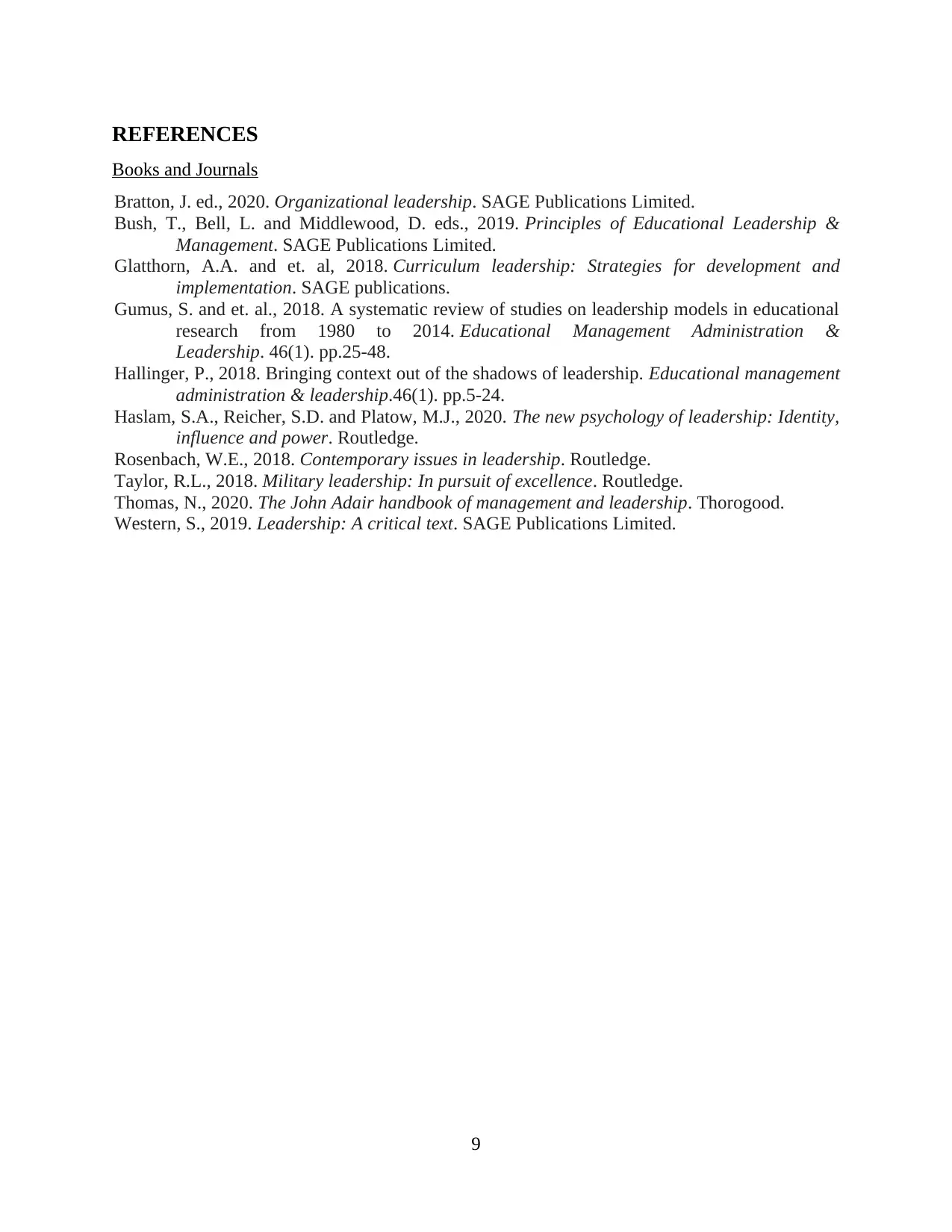
REFERENCES
Books and Journals
Bratton, J. ed., 2020. Organizational leadership. SAGE Publications Limited.
Bush, T., Bell, L. and Middlewood, D. eds., 2019. Principles of Educational Leadership &
Management. SAGE Publications Limited.
Glatthorn, A.A. and et. al, 2018. Curriculum leadership: Strategies for development and
implementation. SAGE publications.
Gumus, S. and et. al., 2018. A systematic review of studies on leadership models in educational
research from 1980 to 2014. Educational Management Administration &
Leadership. 46(1). pp.25-48.
Hallinger, P., 2018. Bringing context out of the shadows of leadership. Educational management
administration & leadership.46(1). pp.5-24.
Haslam, S.A., Reicher, S.D. and Platow, M.J., 2020. The new psychology of leadership: Identity,
influence and power. Routledge.
Rosenbach, W.E., 2018. Contemporary issues in leadership. Routledge.
Taylor, R.L., 2018. Military leadership: In pursuit of excellence. Routledge.
Thomas, N., 2020. The John Adair handbook of management and leadership. Thorogood.
Western, S., 2019. Leadership: A critical text. SAGE Publications Limited.
9
Books and Journals
Bratton, J. ed., 2020. Organizational leadership. SAGE Publications Limited.
Bush, T., Bell, L. and Middlewood, D. eds., 2019. Principles of Educational Leadership &
Management. SAGE Publications Limited.
Glatthorn, A.A. and et. al, 2018. Curriculum leadership: Strategies for development and
implementation. SAGE publications.
Gumus, S. and et. al., 2018. A systematic review of studies on leadership models in educational
research from 1980 to 2014. Educational Management Administration &
Leadership. 46(1). pp.25-48.
Hallinger, P., 2018. Bringing context out of the shadows of leadership. Educational management
administration & leadership.46(1). pp.5-24.
Haslam, S.A., Reicher, S.D. and Platow, M.J., 2020. The new psychology of leadership: Identity,
influence and power. Routledge.
Rosenbach, W.E., 2018. Contemporary issues in leadership. Routledge.
Taylor, R.L., 2018. Military leadership: In pursuit of excellence. Routledge.
Thomas, N., 2020. The John Adair handbook of management and leadership. Thorogood.
Western, S., 2019. Leadership: A critical text. SAGE Publications Limited.
9
1 out of 11
Related Documents
Your All-in-One AI-Powered Toolkit for Academic Success.
+13062052269
info@desklib.com
Available 24*7 on WhatsApp / Email
![[object Object]](/_next/static/media/star-bottom.7253800d.svg)
Unlock your academic potential
Copyright © 2020–2025 A2Z Services. All Rights Reserved. Developed and managed by ZUCOL.





